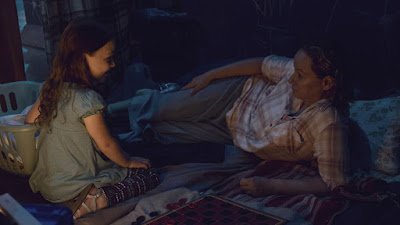 |
| (Photo Credit: AMC) |
The Walking Dead
Season 9, Episode 11
By Garrett Yoshitomi
After several weeks of dipping its toes in the water, The Walking Deadfinally takes the plunge into The Whisperers storyline, as ‘Bounty’ gives us the first face-to-face confrontation between our heroes and Alpha. And, while Alpha and her band of masked followers live up to their billing as one of the show’s creepiest foes, their storyline as a whole loses some of its bite, when juxtaposed with the more upbeat Kingdom side plot that’s featured in this episode. This subplot, in which Ezekiel leads a group from the Kingdom in search of a movie projector bulb, is a perfectly enjoyable story on its own, but ultimately feels out of place when scenes of Jerry singing along to funk music are spliced with the considerably tenser stand-off between Daryl and Alpha.
It can be hard for antagonists to maintain a consistent air of danger and menace, especially for The Walking Dead, which took a perfectly lethal and terrifying Negan, and gradually reduced him to nothing more than a smirking quip with a baseball bat. So far, in the early going of season 9B, The Whisperers are just as frightening as they were during their initial introduction in the midseason finale. Unlike the midseason finale; however, there’s no fog-filled cemetery for these new foes to conceal themselves – they're out in the open and standing at the gates of The Hilltop. Without the element of surprise, it does feel like The Whisperers could be disposed of quite quickly by our heroes. Daryl says as much when he threatens Alpha with “enough firepower to light you up.”
 |
| (Photo Credit: AMC) |
But what The Whisperers may lack in resources, they more than make up for with a frightening feral nature that unsettles even the battle-tested and better armed Hilltop. Any doubts about The Whisperers’ commitment to their animalistic lifestyle are immediately put to rest when one of The Whisperers leaves her baby to be devoured by walkers, rather than let its cries attract more of a herd. A cold-blooded move in the eyes of many, but to Alpha just natural selection. This unfeeling, utilitarian mindset is something we haven’t seen since The Governor. But, unlike The Governor, who’s contrived story arc saw him completely lose his freaking mind less than a year into the apocalypse, The Whisperershave had almost a decade of the end of the world to mold their psychosis into the controlled madness we see today.
If there’s one thing that caninhibit The Whisperers’ threateningness, it’s this episode’s insistence on juxtaposing the seriousness of their storyline with the lightheartedness of The Kingdom’s quest for a movie night. The Walking Dead has a shaky track record of attempting to inject levity into its typically dark subject matter. Sure, the past few seasons have given us memorable lighter moments like Carl snacking on pudding, Rick and Michonne falling through a roof onto a pile of mattresses, and Tara flipping the bird to the entire Oceanside community. But these scenes, while fun in the moment, are just minor detours from the gloom and foreboding that dominate the rest of the episodes they’re a part of.
 |
| (Photo Credit: AMC) |
Simply put, it’s rare for there to be an episode of The Walking Deadthat’s just plain…fun. Rick and Daryl’s buddy road trip episode, ‘The Next World,’ probably comes the closest. And, while it’s unrealistic to except every episode of this show to focus on good time happy sunshine feelings, I feel like it’s an important dynamic to explore that helps us feel more invested in characters by making them seem more relatable, and ultimately creates a stronger sense of dramatic stakes when these characters inevitably come into peril. This week’s movie projector storyline could have accomplished this well, if it had been given the proper attention.
The Kingdom’s inherent whimsical nature and larger than life characters, like Ezekiel and Jerry, fit in well with the lighthearted nature of their quest for a movie projector bulb. Unfortunately, this is a bit hard to appreciate when the episode keeps shifting to the tonally heavier Hilltop storyline. You could argue that this kind of frivolous subplot wouldn’t be able to carry an episode by itself; and thus, needs a more narratively serious A-plot to balance it out. However, this juxtaposed tone that The Walking Deadhas a history of leaning on, ultimately just ends up detracting from both plots- the more fun storyline is dragged down, while the more serious storyline loses some of its dramatic tension.
 |
| (Photo Credit: AMC) |
And, although searching for what’s basically a light bulb may seem less exciting than current events at The Hilltop, an entire episode focused on The Kingdom would have served as a welcome check-in with a significant portion of the cast who are currently on the sidelines of the primary Whisperers arc. Major characters like Carol and Ezekiel have mostly been relegated to the background so far in this post-time jump world, in favor of subplots that take the story through Alexandria and The Hilltop, instead. But, The Kingdom is still a key player in this series, and as hosts to the upcoming community fair, it's likely that their role in the narrative will soon expand. We’re almost to the halfway point of season 9B, and with a couple of build-up episodes taking place recently, you can expect there to be an uptick in action over the coming weeks, before another cooldown leading into a ramp-up to the season finale.









